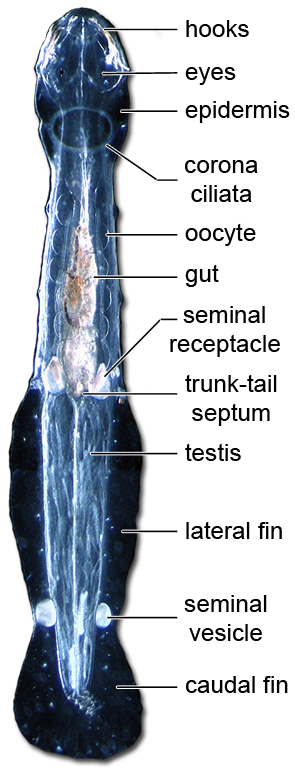Chaetognatha
Chaetognatha, also known as arrow worms, are a phylum of predatory marine invertebrates that play an important role in the oceanic food chain. These small, transparent, planktonic creatures are characterized by their elongated bodies and the presence of grasping spines near their mouths, which they use to capture prey. The name "Chaetognatha" is derived from the Greek words chaite (hair) and gnathos (jaw), referring to these distinctive spines.
Description[edit | edit source]
Chaetognaths are typically a few millimeters to a few centimeters in length, with a body divided into three distinct regions: the head, trunk, and tail. The head carries the grasping spines or chaetae, which are used for hunting, while the trunk and tail house the digestive and reproductive organs, respectively. Their bodies are covered in a transparent cuticle, making them nearly invisible in the water, an advantage against both predators and prey.
Habitat and Distribution[edit | edit source]
Chaetognaths are found in all the world's oceans, from the surface to the deep sea. They inhabit a wide range of environments, including polar, temperate, and tropical waters. Some species are benthic, living near the ocean floor, but the majority are planktonic, drifting with ocean currents.
Ecology and Behavior[edit | edit source]
As voracious predators, chaetognaths play a significant role in marine ecosystems. They feed primarily on other planktonic organisms, such as copepods, crustaceans, and small fish larvae, using their rapid, darting movements and grasping spines to capture prey. Chaetognaths are, in turn, preyed upon by larger marine animals, including fish and cephalopods.
Reproduction among chaetognaths is diverse, with some species being hermaphroditic and others having separate sexes. Fertilization can be internal or external, depending on the species. They have a rapid life cycle and can produce multiple generations per year, contributing to their abundance in marine plankton communities.
Taxonomy[edit | edit source]
The phylum Chaetognatha is divided into two orders: Sagittoidea and Phragmophora. These are further subdivided into several families and genera. The classification of chaetognaths has been challenging due to their simple morphology and the lack of fossil records, but molecular studies have begun to provide insights into their evolutionary relationships with other marine organisms.
Research and Importance[edit | edit source]
Chaetognaths are of interest to scientists for several reasons. They are considered excellent indicators of water masses and ocean currents due to their specific habitat preferences. Additionally, their position in the marine food web makes them important for studies on energy transfer and ecosystem dynamics. Understanding the biology and ecology of chaetognaths is crucial for predicting changes in marine biodiversity and the impacts of climate change on oceanic ecosystems.
Navigation: Wellness - Encyclopedia - Health topics - Disease Index - Drugs - World Directory - Gray's Anatomy - Keto diet - Recipes
Search WikiMD
Ad.Tired of being Overweight? Try W8MD's physician weight loss program.
Semaglutide (Ozempic / Wegovy and Tirzepatide (Mounjaro) available.
Advertise on WikiMD
WikiMD is not a substitute for professional medical advice. See full disclaimer.
Credits:Most images are courtesy of Wikimedia commons, and templates Wikipedia, licensed under CC BY SA or similar.
Contributors: Prab R. Tumpati, MD





